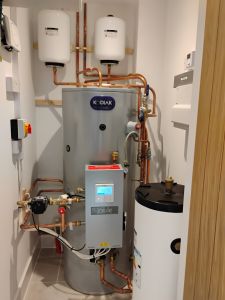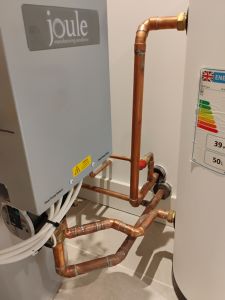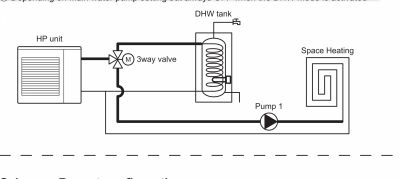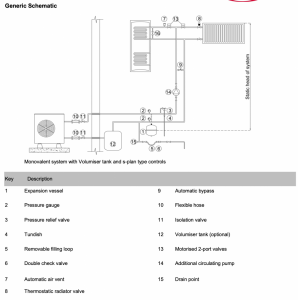Below some photographs of my system.
Had a chat this morning with the plumber and he seems open for suggestions. He claimed the volumiser is there mainly to reduce short cycling (which in his opinion shortens the life of the heat pump) as well as to provide volume for a defrost cycle. He said, as the tank is insulated, I wouldn't be losing much heat at all and probably won't notice any difference if we changed the system.
When I suggested moving it downstream of the diverter, he said he would still suggest to connect the second connections to the buffer to the upstream side. (Hydronic isolation he called it if I understood correctly). Does this make sense?
Posted by: @editora 100-litre buffer tank holds only 1.17kW of energy at a 10°C higher temperature than required, providing just 7 minutes of buffer time for a system with a 10kW load
Surely the buffer tank (on the UFH side) will be more effective when the load is lower, like a single zone asking for heat? Yes, I can see this could lead to some minimum buffer size vs minimum HP power and a certain amount of zones asking for heat. This could well end up needing quite a large buffer tank to make it effective. Probably not a route I'd like to go down.
On the system being oversized, I filled out the 'Freedom' spreadsheet to my best knowledge and got a demand of about 7kW. 12kW would be almost 2x oversized provided my calculations are correct. (The ventilation air change rate losses seems rather large: 42%)
One interseting find during my chat with the plumber is that we found out that the 3-way switch default position (FSV 3071) is set to 'room/normal close'. Could this explain why a defrost cycle could have failed? It's not clear to me how the Samsung controller selects the source for the defrost cycle.
Posted by: @roelOne interseting find during my chat with the plumber is that we found out that the 3-way switch default position (FSV 3071) is set to 'room/normal close'. Could this explain why a defrost cycle could have failed?
The correct position for the 3 port diverter is to fail or be normally closed to heating system - not the cylinder. The reason for this is so the spring return closes the valve once cylinder thermostat is satisfied shutting off the heat source once the cylinder is heated. It doesn't need to be powered closed. If you didn't have this feature you would have to include a 2 port valve as a safety feature and to comply with G3 requirements.
Buffers and volumiser. The meaning of the two is very different and yourself and the plumber seems to be mixing up the use and application.
Volumiser is as it sounds adds volume - nothing more nothing less. It can be installed on the the flow or return, on the return is more normal and energy efficient. A volumiser isn't needed for cylinder heating, put ok to be on the combined return background to the ASHP, but not on the combined flow from the ASHP.
A buffer always provides hydraulic separation, so you have a primary and secondary circuit. Each has its own circulation pump. Generally works against efficiency. Allows a mismatch of primary and secondary flow.
Which do you need?
If your heat pump is big and oversized and/or if you have multiple zones you are likely to need a buffer. This is sized to ASHP minimum volume requirements less the capacity of the smallest zone. It provides a source for defrosting but also keeps the heat pump happy as the primary circulation pump can function correctly.
A volumiser doesn't help an ASHP defrost, if the system isn't allowed full flow by lots of zones being allowed to close down.
Some system configurations
System no buffer above
System with buffer above
System with volumiser above
Many thanks @johnmo for the clarification. This makes it all a bit more clear to me.
Posted by: @Anonymousok to be on the combined return background to the ASHP, but not on the combined flow from the ASHP.
We seem to have a volumiser on the combined flow from the ASHP i.e. not the return. 🙁
The plumber mentioned there was one 'always-on' zone, just couldn't remember which one. (Need to double check) Would that safe the day for the frost cycle?
If this is ok, then the simple solution would be to move the volumiser to the return.
But from your description above it seems a better solution would be to go the way of a buffer as you described in your picture. The plumber wanted to connect the primary buffer side to the combined flow i.e. upstream of the diverter, probably thinking about the defrost cycle again. Someting I need to raise with him.
Posted by: @roel12kW ASHP
Posted by: @roelplumber mentioned there was one 'always-on' zone
You won't get the flow through the system if only that zone is open, even if you did it would make a lot of noise at around 30+l/min, more likely the heat pump will trip on low flow
Do yourself a favour - now, as later you will most likely have to do it
UFH delete all zones, remove all actuators from the manifold. Adding the volumiser to return leg will do no harm, with such a big heat pump.
We stated with zones and thermostats everywhere, it was a disaster for heating efficiency and cost. At the time I was on a boiler and getting rid of zones the half way through the first heating season halved my heating bill. UFH is so slow, you just run at the lowest flow you can get away with and run all the time, keep it warm enough to keep rooms at a steady temp. If your switching a thermostat on or off your flow temp is too high.
Posted by: @roelMany thanks @johnmo for the clarification. This makes it all a bit more clear to me.
Posted by: @Anonymousok to be on the combined return background to the ASHP, but not on the combined flow from the ASHP.
We seem to have a volumiser on the combined flow from the ASHP i.e. not the return. 🙁
The plumber mentioned there was one 'always-on' zone, just couldn't remember which one. (Need to double check) Would that safe the day for the frost cycle?
If this is ok, then the simple solution would be to move the volumiser to the return.But from your description above it seems a better solution would be to go the way of a buffer as you described in your picture. The plumber wanted to connect the primary buffer side to the combined flow i.e. upstream of the diverter, probably thinking about the defrost cycle again. Someting I need to raise with him.
If you wish for your system to operate in a more reliable and efficient manner I suggest that you try the following.
Turn all the room thermostats to a setting of 1C or 2C above the desired room temperature, then adjust the weather compensation curve to produce the desired room temperature. You will probably need to adjust the water flow rate through each of the UFH loops to balance the system. This should allow all the UFH loops to be in service for most of the time. Achieving the correct weather compensation and balancing the system is not a 5 minute job, and can take quite some time under different weather conditions. It should be worth it in the long run.
During milder weather conditions when heating demand is low, the temperature in some rooms may increase due to solar gain, at this point the room thermostat will shut-off that particular UFH loop to help limit the temperature increase. During these conditions the heating demand should be so low that it should have minimal effect on the running cost.
@derek-m Sounds like a good approach.
Would you still suggest changing the volumiser into a buffer tank to assure a defrost cycle?
At one occasion I saw the LWT go beyond the weather compensation level setting (45C while FSV2022 is set to 35C). I wonder if I have some other settings wrong?
FSV 2091 = is set to "Use signal on/off" so the HP starts/stops on the room stats. Should this be set to 2-4 to include weather compensation (Water Law) or does that start the HP cycling again?
@editor Am I cynical in wondering why the two large energy providers design systems eg, BG with a buffer and Octopus with a high flow rate? Both of these are likely (proven?) to increase fuel use and hence costs. The installation cost may be lower which encourages the buyer but what about higher long term costs which benefits energy suppliers. Why can't we have the option of designs say max efficiency and lowest cost/upheaval based on acceptable efficiency? Of course that is ridiculous as what we are offered is the best as they see it? Cynical thoughts off I'll bake some sourdough. 😊
Daikin 6Kw ASHP.
MG4 EV
1926 Semi with loft and wall cavity insulation, all radiator.
Posted by: @roel@derek-m Sounds like a good approach.
Would you still suggest changing the volumiser into a buffer tank to assure a defrost cycle?
At one occasion I saw the LWT go beyond the weather compensation level setting (45C while FSV2022 is set to 35C). I wonder if I have some other settings wrong?
FSV 2091 = is set to "Use signal on/off" so the HP starts/stops on the room stats. Should this be set to 2-4 to include weather compensation (Water Law) or does that start the HP cycling again?
Derek’s approach (as usual) is an excellent one. You do not need a buffer, just a volumiser. Once you understand how your system balances up then it’s possibly a good idea to have your present volumiser moved to the combined return line.
2kW + Growatt & 4kW +Sunnyboy PV on south-facing roof Solar thermal. 9.5kWh Givenergy battery with AC3. MVHR. Vaillant 7kW ASHP (very pleased with it) open system operating on WC
@roel You also may already have a buffer which can also be called a low loss header. @johnmo put in some schematics above. You might be able to trace all the pipe work through to identify all the pieces. I have a suspicion (can anyone be certain?) that Freedom design always includes a LLH.
2kW + Growatt & 4kW +Sunnyboy PV on south-facing roof Solar thermal. 9.5kWh Givenergy battery with AC3. MVHR. Vaillant 7kW ASHP (very pleased with it) open system operating on WC
Posted by: @roel@derek-m Sounds like a good approach.
Would you still suggest changing the volumiser into a buffer tank to assure a defrost cycle?
At one occasion I saw the LWT go beyond the weather compensation level setting (45C while FSV2022 is set to 35C). I wonder if I have some other settings wrong?
FSV 2091 = is set to "Use signal on/off" so the HP starts/stops on the room stats. Should this be set to 2-4 to include weather compensation (Water Law) or does that start the HP cycling again?
If you operate the system as suggested you should not require a volumiser and definitely not a buffer tank.
Let me try to explain how a heat pump system should be operated for improved reliability and efficiency, though optimisation could depend on your home layout as well as system layout.
Think of your home as a vessel, sitting on a beach at the water's edge, with lots of pin holes spaced around the sides of the vessel, so it is not watertight. If you pour water into the vessel some of the water will start to leak out, but if the water level inside the vessel is quite low, the rate of leakage will also be low. If the quantity of water being poured into the vessel is greater than the rate of leakage, the level inside the vessel will start to rise, but in doing so will increase the rate of leakage as more holes start to leak water.
If the flow rate into the vessel is constant, the level will eventually rise to the point where the leakage is equal to the input flow rate and the level will not increase any further. Your home acts in the same way in that if you 'pour' thermal energy into your home, the Indoor Air Temperature (IAT) will rise until the heat loss equals the quantity of thermal energy being poured in.
Now consider the situation when the tide starts to come in. The water level on the outside of the vessel will start to increase, so less holes are open to leakage, which would cause the internal level to rise higher. This is what happens when the Outside Air Temperature (OAT) increases. So to keep the level in the vessel reasonably constant it would be necessary to reduce the quantity of water being poured in, so that it matches the leakage rate at that particular inside and outside water level.
The way a gas or oil boiler normally works is that it pours thermal energy into the home at a rate greater than the leakage, so the IAT starts to rise. To prevent the IAT increasing too high, the boiler is switched off when the temperature reaches a certain level. The IAT then starts to fall due to the present heat loss, at a rate dependent upon the IAT and OAT. To prevent the IAT from falling too low, the boiler is switched back on when the temperature falls to a lower setting. Thermal energy is therefore fed into the home in 'dollops' (technical term).
A heat pump operates in a different manner, in that during the heating season, it tries to vary the quantity of thermal energy being poured into the home to match the rate of leakage, and thereby maintain a reasonably constant IAT. The heat pump performs this task by increasing or reducing the Leaving Water Temperature (LWT), in relation to changes in OAT. It therefore carries out Weather Compensation (WC) control.
During milder weather conditions a heat pump cannot reduce the quantity of thermal energy that it produces below a minimum level, so the IAT and LWT will start to rise and the heat pump will need to be stopped for a period of time to allow the IAT to reduce. The heat pump therefore operates in a similar manner to a gas or oil boiler system.
It is probably more reliable and efficient if when the heat pump is operating that all the heat emitters are being supplied, thereby presenting more load to the heat pump. The fact that more thermal energy has been poured into the home means that it should take longer for it to leak out before the heat is require to supply another 'dollop'.
Unless optimised correctly, a buffer tank can create imbalance within the system that reduces overall efficiency.
A volumiser may be necessary if the volume of water within the system is lower than the specified minimum, this is to assist with defrost cycles. Since defrosting is more likely to occur during the colder weather heating season, by ensuring that all heat emitters are in service the system should have adequate volume and thermal energy. This is why any thermostats should be set at 1C or 2C above the desired room temperature and the actual temperature control is performed by the heat pump controller using WC mode.
@roel can you please post a photo of the buffer/volumiser so that we can see the piping on both sides?
Get a copy of The Ultimate Guide to Heat Pumps
Subscribe and follow our YouTube channel!
- 26 Forums
- 2,396 Topics
- 54.3 K Posts
- 289 Online
- 6,077 Members
Join Us!
Worth Watching
Latest Posts
-
RE: Heat pump not reaching flow temperature
@davec Ive had a look at the screenshots. Lots of th...
By JamesPa , 14 minutes ago
-
RE: Vaillant aroTherm not heating with many faults
When I had a series of apparently unrelated faults my i...
By JamesPa , 31 minutes ago
-
RE: Recommended home battery inverters + regulatory matters - help requested
I cant see how that is the case if the earth is provide...
By JamesPa , 1 hour ago
-
RE: Considering MLCP (Multi-Layer Composite Pipe) for ASHP
OK, TBH I dont know enough about MLCP to comment with a...
By JamesPa , 3 hours ago
-
RE: Predicted Heat Loss from MCS calcs vs EPC vs actual
My gut feeling is that the heat pump is right sized. ...
By Tim441 , 4 hours ago
-

RE: Power outages and storms: A surprisingly good DNO experience
Agreed, which is no more nor less than a customer shoul...
By Majordennisbloodnok , 5 hours ago
-

RE: Running from backup generaor in powercut?
@batpred In our case, 3 times each day when the Octopus...
By Toodles , 6 hours ago
-
RE: Advice for a novice on Mitsubishi Ecodan 6kW
Hi @sheriff-fatman Cycling at 5C and below is usuall...
By RobS , 6 hours ago
-
RE: New Fogstar 15.5kWh upright solution
@batpred Here's the latest Fogstar ready built pack....
By Bash , 8 hours ago
-
RE: RDSAP10 effect on existing heat pump EPC rating?
@mike-patrick yes, even though the current system is ru...
By Tim441 , 8 hours ago
-
RE: Solis inverters S6-EH1P: pros and cons and battery options
Solis confirmed that the S6 works with a single battery...
By Batpred , 8 hours ago
-
RE: Who has a V2G EV installation
I am wondering if in any V2X, would the car battery eve...
By Batpred , 9 hours ago
-

RE: Setback savings - fact or fiction?
Yes, by calculating it manually from the minute data, w...
By cathodeRay , 10 hours ago
-
Fan unit Making terrible noise HELP!!
One of a pair of fan units on an Earth Save Classic II ...
By GutoFfowc , 11 hours ago
-
RE: New Mitsubishi Ecodan 11.2kW installation - L9 errors and maybe more
OK. I think your system, which seems well designed, is...
By JamesPa , 12 hours ago
-

RE: Heatpunk Floor plan issues
It's usually the complete opposite... seldom that Safar...
By Mars , 1 day ago
-

RE: Fan is clipping ice build up from the front of unit.
@majordennisbloodnok I’ll not go there thanks! Toodles.
By Toodles , 1 day ago
-
RE: Running my new Nibe ASHP efficiently
I'm new to the forum. Did you get a reply to this last ...
By Mike @ Camelot , 1 day ago
-

RE: ASHP Energy Consumption: Aira 12kW heat pump
@grantmethestrength MCS requirements for DHW capacity h...
By Toodles , 1 day ago












